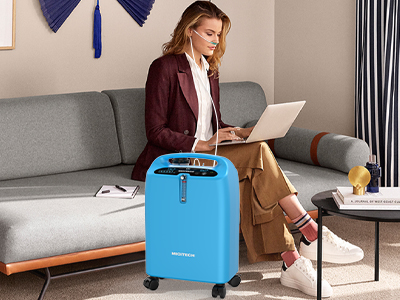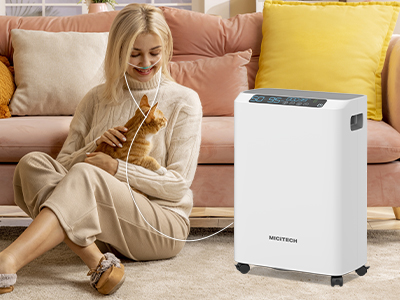06 Nov 2023
Oxygen therapy stands as a cornerstone of modern healthcare, providing life-saving support for individuals with respiratory conditions. Central to this therapy is the use of oxygen concentrators, which raises the question of their role within the framework of clinical policies.
Clinical policies serve as guiding principles in healthcare, ensuring standardization, quality, and safety.

Understanding Oxygen Concentrators
A. Function and Mechanism Oxygen concentrators are medical devices designed to extract oxygen from ambient air, purify it, and deliver it to patients in need. Understanding their functioning is essential for their effective incorporation into clinical policies.
B. Oxygen Concentrator Types 1. Stationary Oxygen Concentrators Stationary concentrators are primarily used in clinical settings, offering a continuous and stable oxygen supply.
2. Portable Oxygen Concentrators Portable devices provide flexibility for patients, allowing them to receive therapy at home or while on the move.

Clinical Guidelines for Oxygen Concentrators
A. Regulatory Standards and Compliance 1. FDA Regulations The U.S. Food and Drug Administration (FDA) sets stringent regulations for medical devices, including oxygen concentrators. Compliance with these standards is paramount.
2. ISO Certification International standards, as defined by the International Organization for Standardization (ISO), further underscore the quality and safety requirements of oxygen concentrators.
B. Prescription Requirements Patient access to oxygen concentrators typically necessitates a prescription from a healthcare provider. This requirement is in line with clinical policies to ensure the devices are used only when medically necessary.
C. Oxygen Concentrator Selection Criteria 1. Patient Assessment Clinical policies emphasize the importance of individual patient assessments to determine the suitability of oxygen concentrators.
2. Oxygen Flow Rate Prescribing the appropriate oxygen flow rate is vital. Oxygen concentrators can be adjusted to match patient requirements.
3. Oxygen Purity Levels Policies dictate the need for high-purity oxygen, particularly in critical medical procedures. Ensuring the concentrator meets these requirements is essential.
Oxygen Concentrators in Clinical Settings
A. Hospital and Clinical Use Oxygen concentrators play a crucial role in hospitals and clinical environments, providing a reliable source of oxygen for various medical procedures and patient care.
B. Home Healthcare and Long-Term Therapy For long-term therapy and home healthcare, clinical policies support the use of oxygen concentrators as a convenient and cost-effective option for patients.
C. Emergency and Disaster Response Clinical policies often outline the deployment of oxygen concentrators in emergency and disaster response scenarios, ensuring that healthcare infrastructure can function effectively under adverse conditions.
Maintenance and Servicing
A. Regular Maintenance Checks Clinical policies require regular maintenance checks to ensure that oxygen concentrators continue to function at optimal levels.
B. Servicing and Repairs In the event of malfunction or wear and tear, prompt servicing and repairs are essential for maintaining a consistent oxygen supply.
C. Compliance with Clinical Policies Healthcare providers must adhere to clinical policies that outline the proper maintenance and servicing of oxygen concentrators to safeguard patient well-being.
Monitoring Patient Progress
A. Oxygen Saturation Monitoring Regular monitoring of patient oxygen saturation is a fundamental component of clinical policies, ensuring that the prescribed therapy is effective.
B. Clinical Assessments Healthcare professionals conduct clinical assessments to evaluate patient progress and make necessary adjustments to the therapy regimen.
C. Adherence to Prescribed Therapy Adherence to the prescribed oxygen therapy is closely monitored to guarantee that patients receive the best care possible.
Insurance and Reimbursement
A. Medical Insurance Coverage Medical insurance policies often include coverage for oxygen concentrators, aligning with clinical policies that recognize these devices as essential for patient care.
B. Reimbursement Policies Reimbursement policies provide a framework for healthcare providers to claim the cost of oxygen concentrators used in patient care.
C. Patient Responsibility Patients are encouraged to be aware of their insurance coverage and reimbursement policies to ensure they fulfill any financial responsibilities associated with oxygen concentrator use.
Conclusion
A. Ensuring Clinical Excellence with Oxygen Concentrators The integration of oxygen concentrators into clinical policies ensures clinical excellence, quality patient care, and safety in oxygen therapy.
B. The Vital Role of Clinical Policies in Healthcare Clinical policies not only regulate the use of medical devices like oxygen concentrators but also establish a framework for patient-centered care, aligning medical technology with the best interests of those it serves.
Keywords: oxygen concentrator
Originally published 06 Nov 2023, updated 06 Nov 2023.